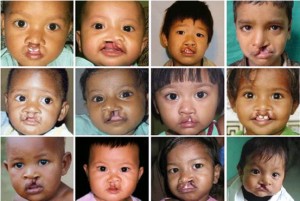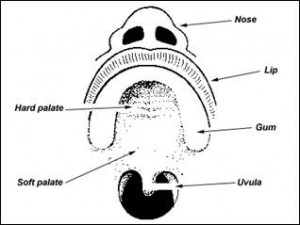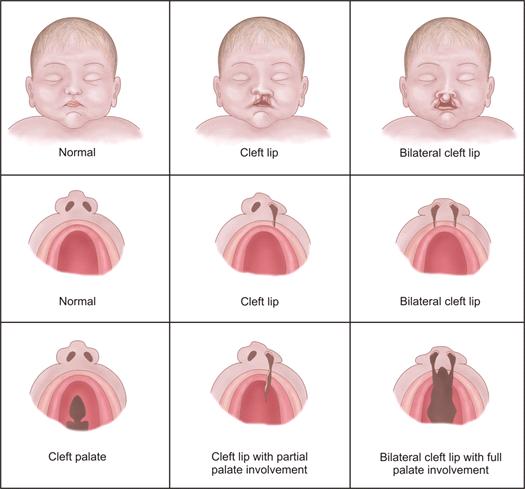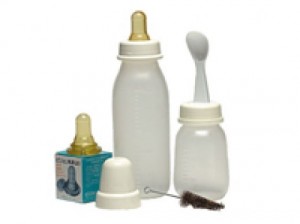
© World Love and Peace Foundation
Cleft lip and cleft palate are one of the common birth defects found in the United States and around the world. A cleft is an abnormal space or gap in the upper lip or palate that is present at birth. Cleft lip is also known as harelip to some. The finding of a cleft deformity in an affected baby can be a considerable shock to the parents but be rest assured for the defects are correctable and the child’s future need not be adversely affected. However parents have to be mentally prepared for a long course of therapy to correct the cleft disfigurement.
Some cleft lip and cleft palate facts
- In the United States, the occurrence of cleft lip and cleft palate has been estimated to be 1 in 700 births.
- Boys are more prone to cleft lip and palate (together) whereas cleft palate (by itself) is seen more often in girls.
- Cleft lip and palate occur 2-3 times more than cleft palate.
- Unilateral (one-sided) clefts are more common than bilateral (two-sided) clefts with the left side more frequently involved.
Cleft lip and cleft palate symptoms

Related anatomy for oral clefts © http://www.chw.edu.au/
Oral clefts are detected by birth and commonly involve the lip, alveolar ridge (the ridge that forms the borders of the upper and lower jaws and contains the sockets of the teeth), and hard and soft palates. The cleft can be incomplete, which the cleft does not extend entirely from the lip to the soft palate. Cleft lip can occur without cleft palate and vice versa.
Clefts of the lip can vary from a small notch on the edge of the lips to a wide cleft that divides the floor of the nose. Clefts of the soft palate may range from a bifid uvula to a wide inoperable cleft. The most minor form of a cleft palate is the bifid uvula whereby only the uvula (the fleshy lobe at the back of the soft palate) is clefted. Some clefts which are not readily seen during examination of the mouth are called submucosal clefts or occult clefts.

Cleft lip and cleft palate causes
The exact cause for clefts is unknown for most cases and no single factor can be identified as the cause. Cleft lip and cleft palate may be caused by:
- Associated diseases – Clefts have been seen as a feature in over 300 syndromes, most which are rare.
- Genetics
- Environmental factors – Nutritional deficiencies, radiation, several drugs, viruses, smoking, and alcoholism can produce clefting in certain situations.
Cleft lip and cleft palate problems/complications
- Dental problems – delayed eruption, missing or extra teeth
- Mal-aligned bite
- Feeding difficulties
- Ear problems – hearing defects, ear infection
- Deformity of the nose
- Speech difficulties
- Aesthetics issues if cleft lip is present
- Associated anomalies – inborn heart disease, mental retardation etc.
Cleft lip and cleft palate treatment
Rehabilitation of individuals with cleft deformities must address their appearance, speech, hearing, chewing and swallowing. Therefore management of cleft lip and cleft palate is best undertaken by a team of professionals.
Cleft teams are found in most cities and usually comprise of:
- a plastic surgeon or an oral and maxillofacial surgeon,
- a general or pediatric dentist,
- a pediatrician,
- an orthodontist,
- a prosthodontist,
- an otorhinolaryngologist (a specialist that deals with the ear, nose and throat),
- an audiologist,
- a speech therapist,
- a psychologist or psychiatrist,
- a social worker
The number of specialists required depends on the severity of the clefts and the problems faced by the affected individuals.
Sequence of treatment

Specially designed feeding bottles for cleft palate babies
- Pre-dentition Phase (up to 6 months old) – surgical repair of cleft lip at 3 months or before to restore facial appearance. Use feeding plates or enlarge the opening of the teat of milk bottle to prevent milk entering into the nose.
- Primary dentition Phase (6 months to 6 years old) – cleft palate surgery is performed at 12 months of age. Reconstruction of the palate before the child attempts to speak help reduce the severity of speech defect.
- Mixed dentition Phase (6 to 12 years old) – secondary cleft lip and cleft palate repair. Typical nose deformity is corrected between 8 to 11 years old by alveolar bone grafting.
- Adolescent Phase (12 to 18 years old) – active orthodontic management is required. By 18 years of age, any residual deformity will need surgical correction.
- Adult Phase (more than 18 years old) – orthognathic surgery can be ideally undertaken and finally a suitable prosthesis will restore the dental occlusion.
Cleft lip and cleft palate support
 There are various cleft palate foundations around the world. Further information about cleft palate in the United States can be found at American Cleft Palate Craniofacial Association (www.acpa-cpf.org) or Cleft Palate Foundation (www.cleftline.org) where you can download booklets and fact sheets concerning variety of issues related to cleft lip and palate.
There are various cleft palate foundations around the world. Further information about cleft palate in the United States can be found at American Cleft Palate Craniofacial Association (www.acpa-cpf.org) or Cleft Palate Foundation (www.cleftline.org) where you can download booklets and fact sheets concerning variety of issues related to cleft lip and palate.
Pingback: What Dental Corrective Surgery Could Do For You Part 1 | Intelligent Dental
Cleft lip and cleft palate are problems that occur often in infants and can lead to other health problems if not corrected. The good news is that they can be corrected through surgery. However, in other parts of the world, surgery may not be available or may not be an option because of the cost. For this reason there is a Cleft Palate Foundation dedicated to helping children in all parts of the world receive the medical help that they need.
Pingback: Why is Oral Health so Important? | Intelligent Dental
i want to knw why cleft lip is more common on left side? wat is the genetics behind this? or any vascular insufficiency?
From what I have been taught, the left side is more common from data researches conducted throughout the years. I couldn’t find the reason behind it but I’ll update you if I ever do.
I’m 15 years old can I still have cleft lip and palate plastic sugery
@patel Surgery may vary depending on the treatment plan proposed by your doctor but as an overall, surgery will be needed till you reach adulthood to correct any incorrect bite.